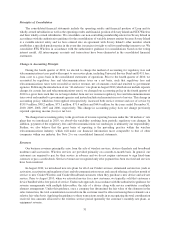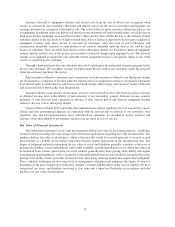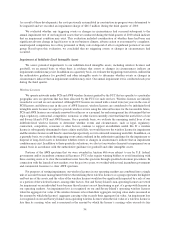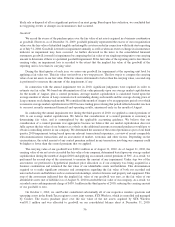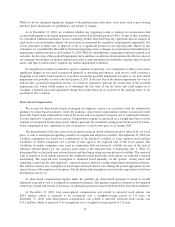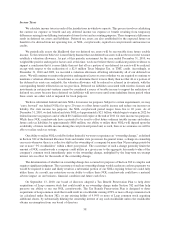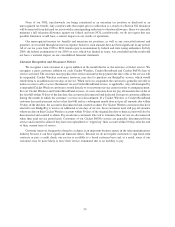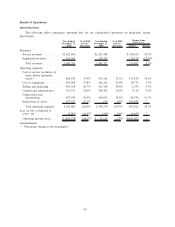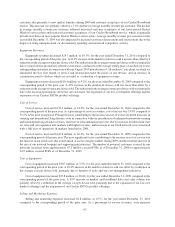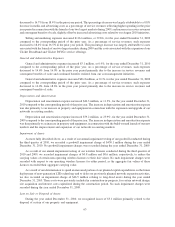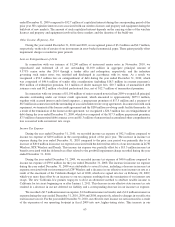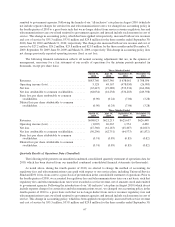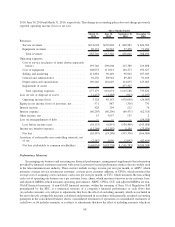Cricket Wireless 2010 Annual Report Download - page 64
Download and view the complete annual report
Please find page 64 of the 2010 Cricket Wireless annual report below. You can navigate through the pages in the report by either clicking on the pages listed below, or by using the keyword search tool below to find specific information within the annual report.Income Taxes
We calculate income taxes in each of the jurisdictions in which we operate. This process involves calculating
the current tax expense or benefit and any deferred income tax expense or benefit resulting from temporary
differences arising from differing treatments of items for tax and accounting purposes. These temporary differences
result in deferred tax assets and liabilities. Deferred tax assets are also established for the expected future tax
benefits to be derived from net operating loss, or NOL, carryforwards, capital loss carryforwards and income tax
credits.
We periodically assess the likelihood that our deferred tax assets will be recoverable from future taxable
income. To the extent we believe it is more likely than not that our deferred tax assets will not be recovered, we must
establish a valuation allowance. As part of this periodic assessment for the year ended December 31, 2010, we
weighed the positive and negative factors and, at this time, we do not believe there is sufficient positive evidence to
support a conclusion that it is more likely than not that all or a portion of our deferred tax assets will be realized,
except with respect to the realization of a $2.0 million Texas Margins Tax, or TMT, credit. Accordingly, at
December 31, 2010 and 2009, we recorded a valuation allowance offsetting substantially all of our deferred tax
assets. We will continue to monitor the positive and negative factors to assess whether we are required to continue to
maintain a valuation allowance. At such time as we determine that it is more likely than not that all or a portion of
the deferred tax assets are realizable, the valuation allowance will be reduced or released in its entirety, with the
corresponding benefit reflected in our tax provision. Deferred tax liabilities associated with wireless licenses and
investments in certain joint ventures cannot be considered a source of taxable income to support the realization of
deferred tax assets because these deferred tax liabilities will not reverse until some indefinite future period when
these assets are either sold or impaired for book purposes.
We have substantial federal and state NOLs for income tax purposes. Subject to certain requirements, we may
“carry forward” our federal NOLs for up to 20 years to offset future taxable income and reduce our income tax
liability. For state income tax purposes, the NOL carryforward period ranges from five to 20 years. As of
December 31, 2010, we had federal and state NOLs of approximately $2.1 billion, which begin to expire in 2022 for
federal income tax purposes and of which $0.3 million will expire at the end of 2011 for state income tax purposes.
While these NOL carryforwards have a potential to be used to offset future ordinary taxable income and reduce
future cash tax liabilities by approximately $800 million, our ability to utilize these NOLs will depend upon the
availability of future taxable income during the carryforward period and, as such, there is no assurance we will be
able to realize such tax savings.
Our ability to utilize NOLs could be further limited if we were to experience an “ownership change,” as defined
in Section 382 of the Internal Revenue Code and similar state provisions. In general terms, a change in ownership
can occur whenever there is a collective shift in the ownership of a company by more than 50 percentage points by
one or more “5% stockholders” within a three-year period. The occurrence of such a change generally limits the
amount of NOL carryforwards a company could utilize in a given year to the aggregate fair market value of the
company’s common stock immediately prior to the ownership change, multiplied by the long-term tax-exempt
interest rate in effect for the month of the ownership change.
The determination of whether an ownership change has occurred for purposes of Section 382 is complex and
requires significant judgment. The occurrence of such an ownership change would accelerate cash tax payments we
would be required to make and likely result in a substantial portion of our NOLs expiring before we could fully
utilize them. As a result, any restriction on our ability to utilize these NOL carryforwards could have a material
adverse impact on our business, financial condition and future cash flows.
On September 13, 2010, our board of directors adopted a Tax Benefit Preservation Plan to help deter
acquisitions of Leap common stock that could result in an ownership change under Section 382 and thus help
preserve our ability to use our NOL carryforwards. The Tax Benefit Preservation Plan is designed to deter
acquisitions of Leap common stock that would result in a stockholder owning 4.99% or more of Leap common stock
(as calculated under Section 382), or any existing holder of 4.99% or more of Leap common stock acquiring
additional shares, by substantially diluting the ownership interest of any such stockholder unless the stockholder
obtains an exemption from our board of directors.
58





